After years of trial and error, I finally came up with the perfect DIY succulent potting soil mix. This is the best, and it’s super easy to make too!
In this post, I will share my homemade recipe and ingredients with you, and show you exactly how to make your own.
I don’t buy succulent soil, I make my own. It’s much cheaper than the commercial stuff. I find that those pre-made mixes (at least the stuff I’ve purchased in the past) are light on drainage, and hold more water than I like.
So way back in 2013, I came up with my own mix, and it’s perfect! I’ve been using it for all of my succulents ever since, and they love it.
My goal in developing this recipe was to use common ingredients that you can find at your local garden center, big box store, or online. Plus, I use them to make my other homemade potting soils too, so they are all very reusable.
The Best Soil For Succulents
The best type of potting soil for succulents is a well draining, sandy mix that allows the water to flow through quickly, without becoming compacted.
When readers reach out to me about problems with their plants, most of the issues they have are caused by overwatering. This is by far the #1 cause of death for succulent plants, and that is why it is so important to use the right type of soil for them.
If you don’t want to make your own, then you should buy a high quality brand. Read the package to make sure it’s porous, drains quickly, and does not retain moisture.
Related Post: How & When To Water A Succulent Plant
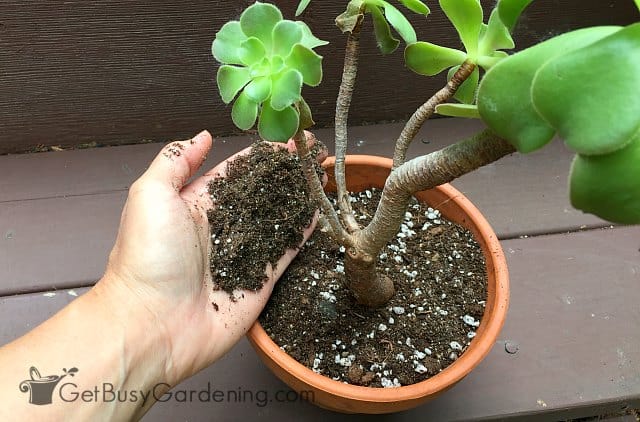
How To Make Succulent Soil
Below you’ll find all of the details about how to make your own. Since you control the ingredients, you can modify my potting soil recipe to get the perfect mix that both you and your succulent plants will love.
Supplies Needed
You’ll only need a few supplies to mix your succulent soil. So grab these items before you get started…
- Measuring container* (to measure your ingredients)
- Hand trowel
- Container for mixing (I use a bucket or my table top potting tray)
* You can use anything for this, like a measuring cup, a scoop, or a hand trowel.
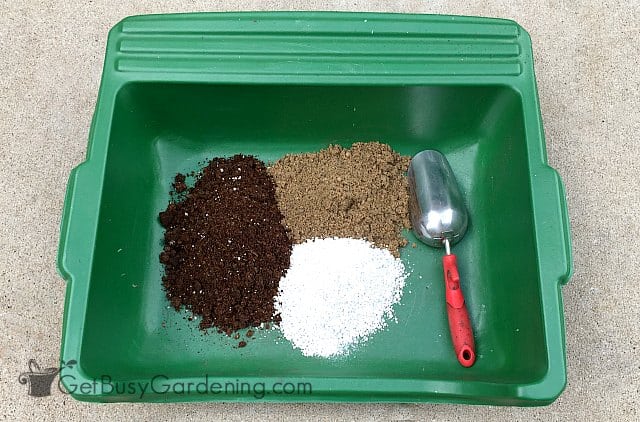
DIY Succulent Soil Recipe
You only need 3 ingredients for this recipe. You should be able to find them at any garden center, home improvement or big box store, or order them online.
- 3 parts potting soil
- 2 parts coarse sand (turface or poultry grit)
- 1 part perlite (or pumice)
What is a “part”? – A “part” is just a generic unit of measure. For example, if you use a 1 cup measure, then this recipe converts to 3 cups potting soil, 2 cups sand, and 1 cup perlite.
Related Post: How To Make Your Own Cactus Soil Mix (With Recipe!)
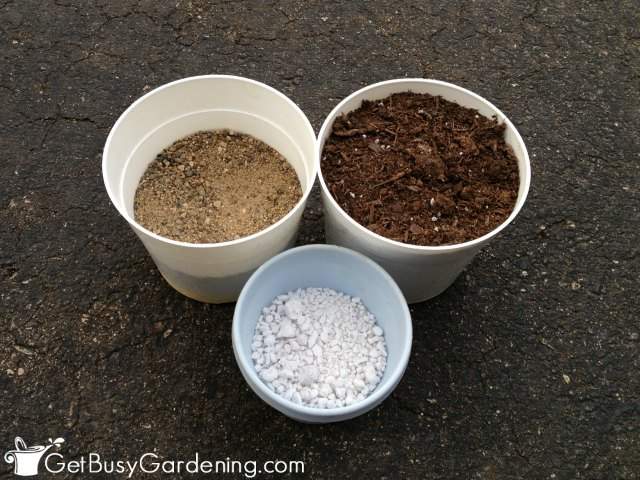
How To Mix Potting Soil For Succulent Plants
Making your own DIY succulent potting soil is very quick. All you need to do is dump everything into your mixing container (bucket, potting tray, wheelbarrow… whatever) and stir it all together.
Use a trowel, a large spoon, or your hands to mix it. Just make sure the ingredients are evenly combined once you’re done. That’s it. Told you it was easy.
Related Post: How To Grow & Care For Aloe Vera Plants
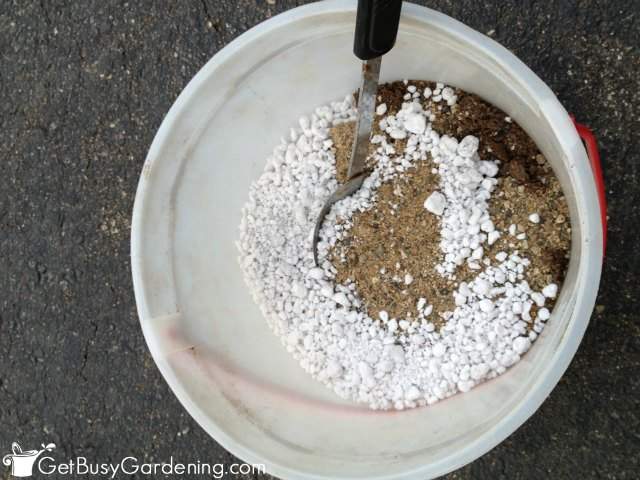
DIY Succulent Potting Soil Ingredients
Below I will describe each of the 3 ingredients you need, and also give you alternatives that you can use if you can’t find any of these locally.
All Purpose Potting Soil
Pretty much any type of regular potting soil will work as the base to make your succulent soil. Use whatever you have on hand (as long as it’s fresh and sterile).
However, don’t use cheap dirt, garden soil, mixes that contain vermiculite, or any type that says it has added moisture control or retains water. Succulents need a well draining potting soil, not one that holds moisture.
Related Post: Succulent Plant Care & Ultimate Growing Guide
Coarse Sand
To prevent soil compaction, I recommend buying coarse sand rather than the really fine stuff. If you prefer, you could use turface or poultry grit as a substitute instead.
Just don’t use sand from the garden, the beach, or a sandbox (you never know what nasties will be in there).
Related Post: How To Care For A Jade Plant (Crassula)
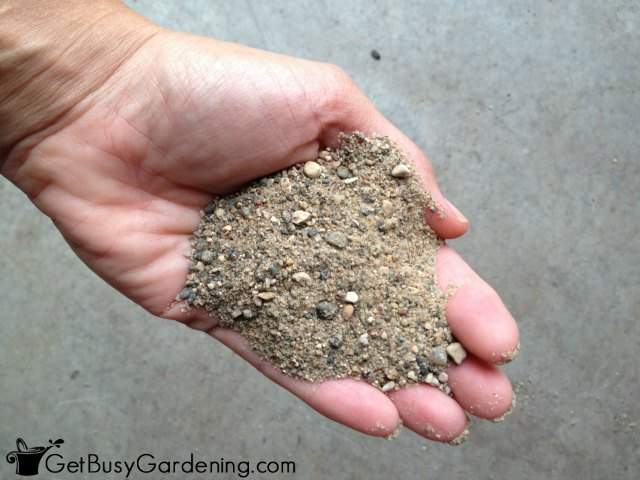
Perlite or Pumice
Perlite is a very lightweight organic soil amendment. It’s the white pieces that look like Styrofoam that you see in many commercial mixes.
It retains very little moisture, prevents compaction, and adds drainage – which is exactly what we want for our succulent potting soil.
You can usually buy perlite at any garden center or home improvement store. But sometimes it’s hard to find, so you can substitute for pumice if that’s easier to get where you live.
Related Post: Propagating Succulents From Stem Cuttings Or Leaves
Storing Your Leftover Succulent Soil Mix
You could mix up a big batch and store the leftovers for later. That way you’ll always have some homemade potting soil on hand when you need it for repotting your succulents.
You can keep it on a shelf in your basement, garage, or a shed. But make sure to put it in an air-tight container so bugs can’t get in.
If you don’t have an air-tight container, you can buy one of these bucket sealing lids, which works with a five gallon bucket.
Related Post: How To Make An Indoor Succulent Garden
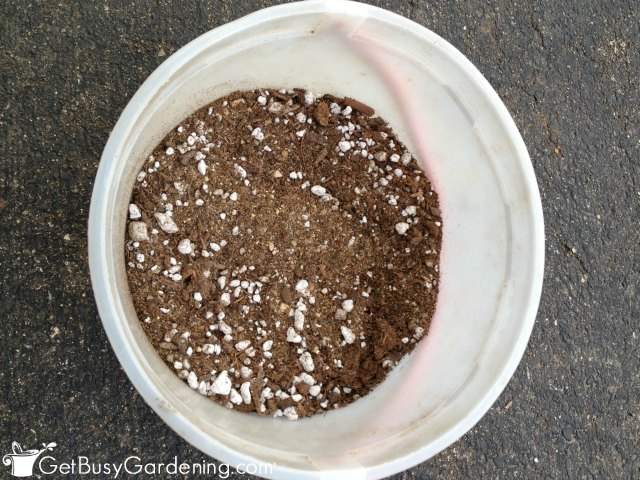
FAQs
You certainly could use regular potting soil for your succulents. However, make sure that it dries out completely between waterings, or they will rot.
Planting your succulents in regular potting soil increases the risk of overwatering, because it tends to retain too much moisture. It’s best to use a fast-draining, porous mix instead.
The differences between general potting soil and a succulent mix are the ingredients and the consistency. Regular potting soils are made of organic materials that retain moisture, while succulent soil is porous, and designed to drain very quickly.
My succulents do very well in my DIY potting mix, and making my own saves me tons of money. Now that you know how to make it, your plants will thrive too.
Do you make your own succulent soil? Share your recipe or tips in the comments section below.
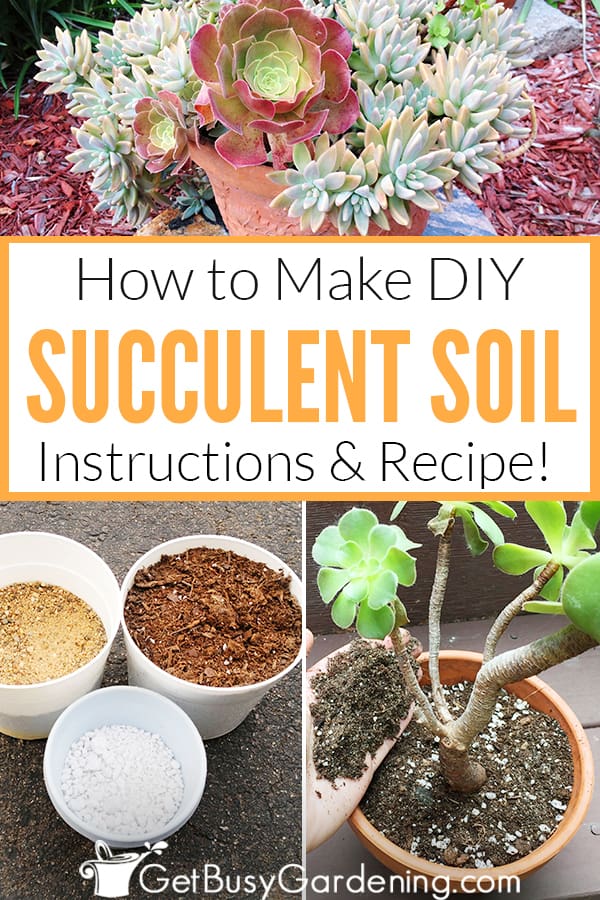

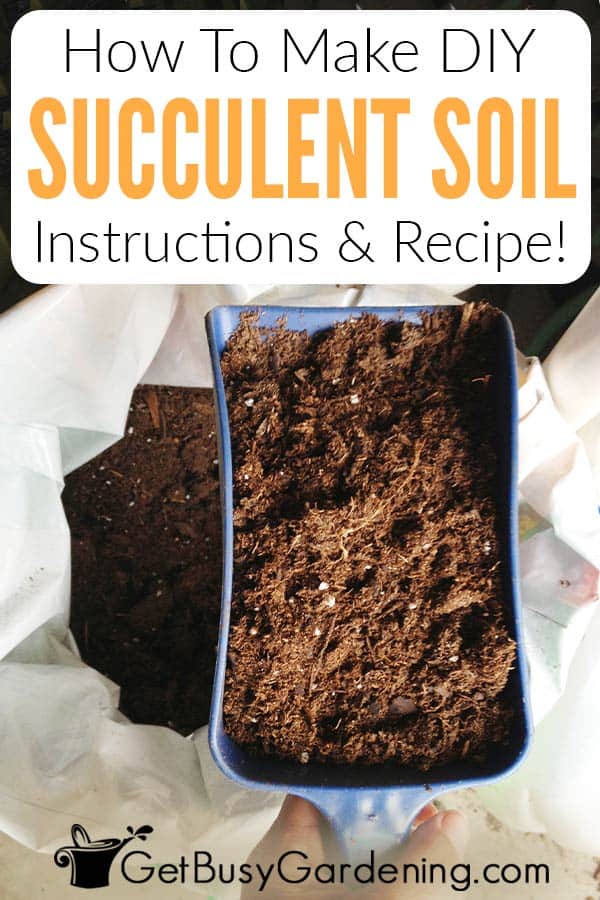
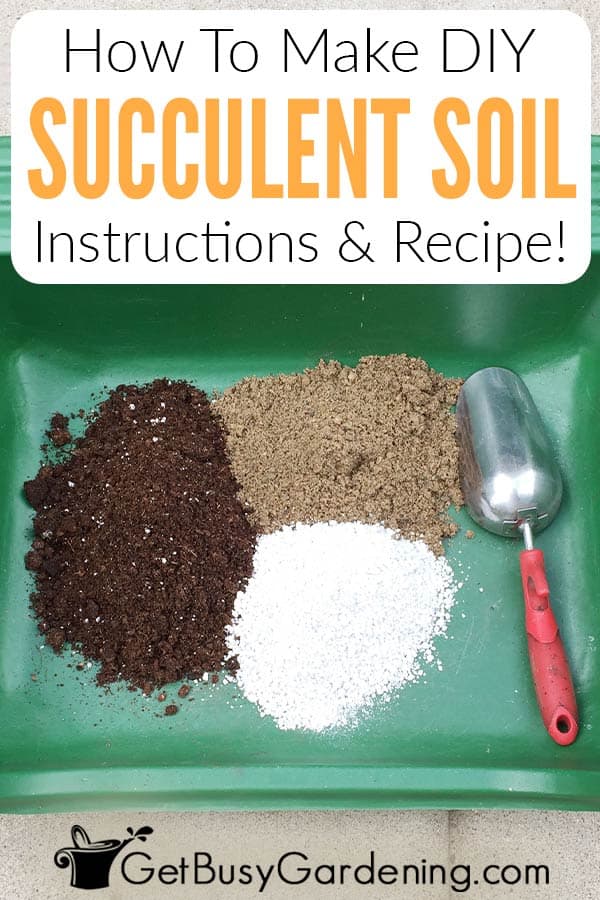


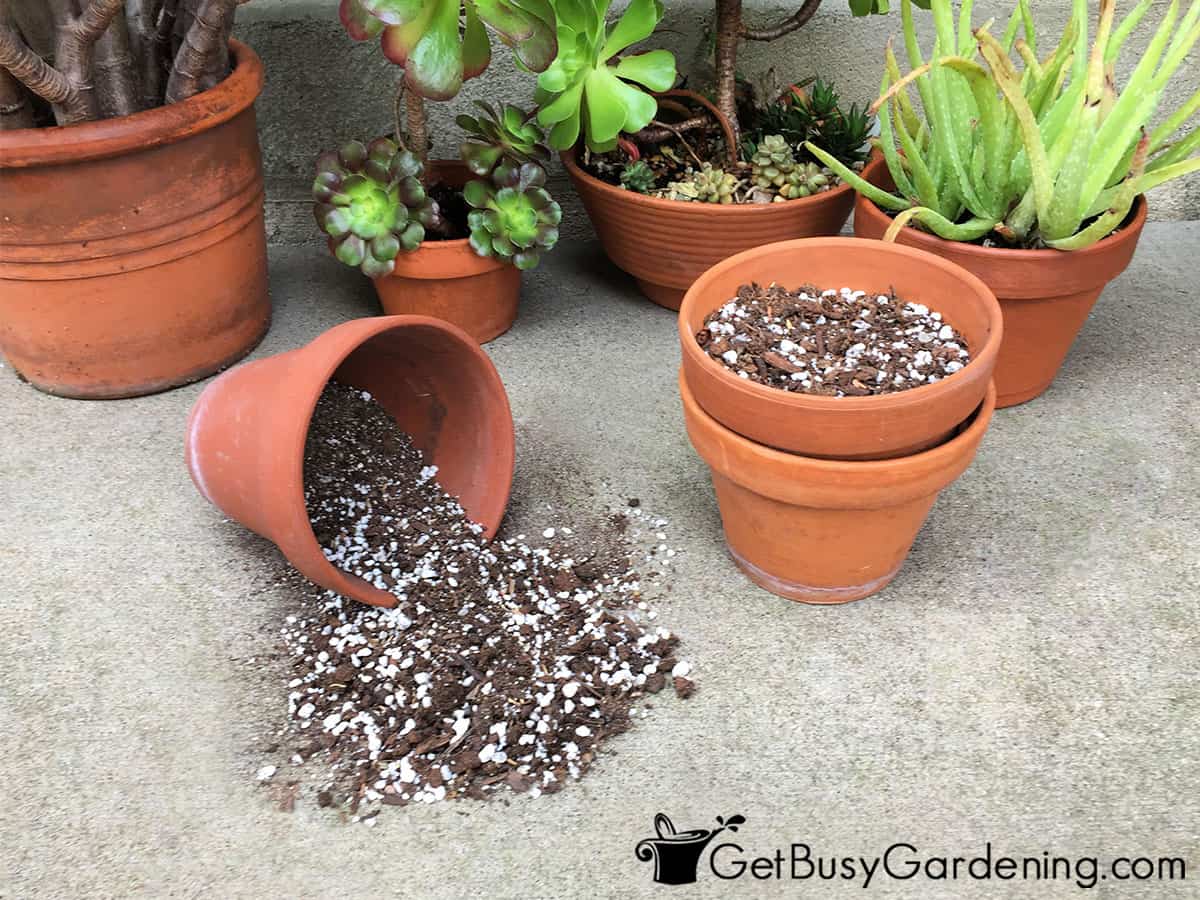


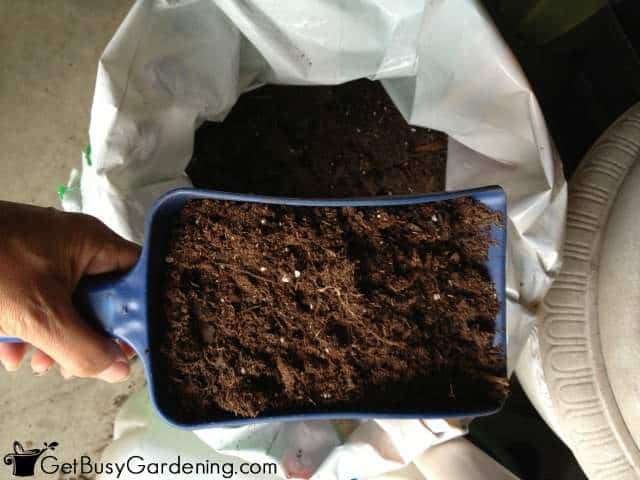
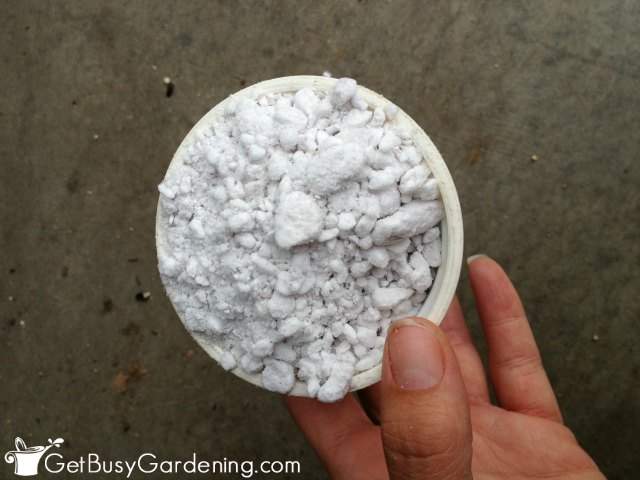

Connie Hill says
I just inherited a Japanese Poinsettia. The plant has several branches from the main flower. What is the best way to prune it? Everyone wants me to cut it, but I’m not sure.
Thank you
Amy Andrychowicz says
You certainly don’t need to prune it, unless it’s getting too tall or large for your space or it’s becoming very leggy. But if you want to learn more, my general plant pruning guide is a great place to start.
Elisabeth F. Gardner says
Is regular soil better than coco coir for succulents l have the original mixture left, can I just add sand?
Thank you, Elisabeth
Amy Andrychowicz says
You can use your regular potting mix to make succulent soil using my recipe, it will work great. Pure coco coir tends to hold too much moisture for succulents.
Peggy says
Would this succulent soil be appropriate for an indoor Norfolk Island Pine tree?
Amy Andrychowicz says
No, succulent soil would not be rich or acidic enough for them. I recommend trying my general purpose indoor plant potting soil recipe, which you could amend with sand or extra perlite to make add more drainage.
Peggy says
Thank you!
Amy Andrychowicz says
You’re welcome!
Aimee says
I have a box of bonsai soil- no label- it looks like a bunch of rocks, maybe some bark. Can I mix that with potting soil? Would I need to add anything else? Thanks in advance!
Amy Andrychowicz says
You could mix it with regular potting soil to make a custom succulent medium. However it’s very difficult for me to recommend the proportions, since I don’t know the exact makeup of the one you have, sorry. But you could definitely experiment with it if you’re feeling brave. 🙂
Aimee says
Thanks!
Amy Andrychowicz says
You’re welcome!
Laurel says
My husband bought me MiracleGro potting soil. I didn’t know it took sand too, but I thought, wait, will diatomaceous earth work? It said it was excellent for succulents so I mixed that 25% with the soil. I hope that is ok. At least there won’t be any bugs! If the plants look bad I will have to repot in something else. When I saw you said sea shells, I thought okay!! Wish me luck. I am new to this.
Amy Andrychowicz says
I think diatomaceous earth is too fine of a powder though, and may cause compaction. When I mentioned seashells, I was referring to poultry grit, which is much coarser and chunkier, so that’s why that product would work. But good luck on your experiment, hope your succulents will love your mix.
Nell Chambers says
This site is just what I need. Thank you.
Nell from England
Amy Andrychowicz says
You’re welcome, thanks for your nice comment. 🙂
Viji says
Can I use succulent mix, coarse river sand and gravel (instead of perlite)?
Amy Andrychowicz says
You could certainly give it a try. I’ve never used that combination for my succulent soil recipe, but it’s always fun to experiment to see what works best for you.
Henry Acres says
Just a heads up…you can find pumice at your local feed store, but make sure it says Dry Stall, and not Stall Dry, which is basically cat litter. Thanks for your great read.
Amy Andrychowicz says
Thanks for the tip, and you’re welcome. 🙂
Brad says
G’day,
I’ve gained a load of succulents and Cacti over the years and now wishing to make some sales from the propagation that I’ve had great success with. Now it’s time to pot them up. So my question is can I add 1 or 2 parts of chicken pellets for a bit of organic fertiliser or should I just keep going with a suitable liquid fertiliser for succus and Cacti?
I’m from the land down under Sydney.
Amy Andrychowicz says
You can use granules or a liquid, that part doesn’t matter. Succulents aren’t usually heavy feeders, so you really only need to feed them a few times during the summer. But it’s a good idea to research the specific variety you have in order to know the exact feeding requirements. Don’t give them any in the winter, or it could cause leggy growth. Here’s more details… Succulent Plant Care & Ultimate Growing Guide.
Sara says
Will pea gravel also work in place of coarse sand? When I do a search for coarse sand it pulls up results for pea gravel or the coarse sand used in cement mixing
Amy Andrychowicz says
It would probably work, but pea gravel is much larger than the coarse sand I recommend (linked to in the ingredients list above). So it will add more weight to the container. I have not tried it myself, but you could certainly experiment.
Warda Yasin says
Hello
I’m a new plant parent and have bought succulents for the first time. There is a little baby succulent in the pot, but I have noticed that it has not grown at all in months now. What shall I do?
Amy Andrychowicz says
Check out my ultimate care guide for how to grow succulents for detailed instructions.
Ellie says
Can I mix potting soil, crushed volcanic rocks & perlite for succulents soil?
Amy Andrychowicz says
As long as the crushed rock is small like the coarse sand I mentioned, then it should work. I have never tried that as a substitue in this recipe though, so I can’t say for sure.
Melanie says
Would this mix work to start succulents from seeds?
Amy Andrychowicz says
Yes!
Joanna T Simon says
Can I use vermiculite with commercial potting soil for my echeverias?
Amy Andrychowicz says
No, vermiculite is water retentive, and you don’t want that for succulents.
Bonnie says
Most poultry grit I see have probiotics and vitamins in it. Is this okay to use for the potting soil?
Amy Andrychowicz says
As long as the poultry grit is coarse and not fine, and the main ingredients are crushed seashells and/or crushed granite without a ton of extra stuff added in, then it will work.
Bonnie says
many thanks
Jennifer says
Hello,
Can i mix succulents soil, river sand and perilite?
Do i need to add river rocks?
Thanks
Amy Andrychowicz says
As long as the river sand that you have is coarse and not fine, then it should work. You do not need to add any extra rocks to the mix.